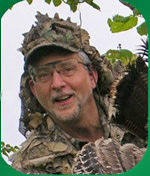The Gray Ghosts of September
by Ed Migale
Each year, in the first dim light just before sun up, on the first
day of September, the first dove I see always seems to appear
out of nowhere.  There is nothing to be seen in the half-light,
and then … THERE!
There is nothing to be seen in the half-light,
and then … THERE!
As if floating like a ghost – but in reality moving forward at a deceivingly quick pace – spotting that dove is the most anticipated moment of my new hunting season. It tells me all is right in the world; that the annual life cycle of the hunter and his prey is to be fulfilled once again. A magic moment, to be sure.
Their daring, uneven flight characteristics have earned these tiny speedsters all kinds of names, many of which we can’t put in print. Here are some tips that will help you call doves “delicious”.
Perhaps that is one of the most alluring aspects of dove hunting. But there are two others that come to mind, such as the unparalleled gunning challenge offered by these fleet-of-wing creatures. Mutually inclusive to hitting – versus missing – is dove breast meat, stuffed inside a wedge of fresh pasilla pepper, alongside some firm jack cheese, wrapped with bacon and sprinkled with salt, pepper and paprika then grilled over mesquite coals and served with a spicy Zinfandel. Fantastic!
But a lot of dove hunters never get to enjoy very much in the way of eating these delicious birds. Why? Because they miss what are arguably – and in their defense – the bird many consider the toughest target in all of wingshooting.
Now it might be easy to say “well if doves are wingshooting’s toughest targets, then it is entirely understandable that most hunters would miss most of the time.” A good argument. But an argument with a few chinks in its armor because you can shoot a higher percentage if you pay attention to a few details.
So here are some tips that will help you miss less often on doves this September.
- Pick the Right Gun — When it comes to picking your dove gun, don’t listen to anyone else’s advice … including mine. Just shoot the gun you are most comfortable with and do your best shooting with. I especially don’t care what gauge it is. 12, 16, 20, 28, .410; they are all good. Can you shoot it? Does it swing well and allow you to track these swift and erratic ghost-like birds? Those are the “to be or not to be” questions, not “what gauge is it?”
- Pick the Right Choke — This part of the gun is -- pardon the pun -- fair game for discussion. I believe that a good dove gun will have screw-in, changeable choke tubes. Here’s why: Doves are found in lots of different habitats, and behave differently based on those habitats and the hunting pressure on them. For example, doves gliding gently through tree branches surrounding a watering hole on opening day present a much different target than high crossing, fast flying fence-line doves do a week into the season. The former require a very open choke; the latter something tighter.
- Pick the Right Ammunition — Ammo and chokes are really part of the same discussion. Those water hole doves can be taken with light loads of smaller shot, like 1 ounce of # 8’s in the 12 gauge or 7/8 of an ounce of #8’s in the 20. But for the high crossers, I like to move up in payload and shot size, say 1 1/8 or 1 ¼ ounces in the 12 and 1 ounce in the 20. # 7 ½’s fill the ticket here, as do # 7’s and even # 6’s.
- Pick the Right Spot — Think location, location, location. Watch for doves flying specific routes. As soon as you see a pattern developing put yourself in position to intercept the doves as the fly towards you. That way you’ll get what are known as “incoming” targets, which, because they require less lead than “crossing” targets, are easier to hit.
- Pick your Best Shot — The biggest mistake I see dove hunters make is that they shoot at every dove they see that is anywhere close to being in range. What’s wrong with that you say? After all, they’re afield to try to get some doves, right? Well, yes, and no. The problem is that when the hunter takes marginal shots, he or she often misses. Then the hunter is left standing there with an unloaded gun at precisely the time another gray ghost appears, only this time at a slower speed and better angle than the previous attempt.
You don’t have to believe in or be afraid of these feathered ghosts. Do all the above and you’ll be able to pick the feathers off your share of doves this September. The BBQ is waiting.
